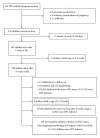Effect of Formula Feeding and Breastfeeding on Child Growth, Infant Mortality, and HIV Transmission in Children Born to HIV-Infected Pregnant Women Who Received Triple Antiretroviral Therapy in a Resource-Limited Setting: Data from an HIV Cohort Study in India
- PMID: 22701801
- PMCID: PMC3371722
- DOI: 10.5402/2012/763591
Effect of Formula Feeding and Breastfeeding on Child Growth, Infant Mortality, and HIV Transmission in Children Born to HIV-Infected Pregnant Women Who Received Triple Antiretroviral Therapy in a Resource-Limited Setting: Data from an HIV Cohort Study in India
Abstract
We describe a programme for the prevention of mother-to-child transmission (PMTCT) of HIV that provided universal antiretroviral therapy (ART) to all pregnant women regardless of the CD4 lymphocyte count and formula feeding for children with high risk of HIV transmission through breastfeeding in a district of India. The overall rate of HIV transmission was 3.7%. Although breastfeeding added a 3.1% additional risk of HIV acquisition, formula-fed infants had significantly higher risk of death compared to breastfed infants. The cumulative 12-month mortality was 9.6% for formula-fed infants versus 0.68% for breastfed infants. Anthropometric markers (weight, length/height, weight for length/height, body mass index, head circumference, mid-upper arm circumference, triceps skinfold, and subscapular skinfold) showed that formula-fed infants experience severe malnutrition during the first two months of life. We did not observe any death after rapid weaning at 5-6 months in breastfed infants. The higher-free-of HIV survival in breastfed infants and the low rate of HIV transmission found in this study support the implementation of PMTCT programmes with universal ART to all HIV-infected pregnant women and breastfeeding in order to reduce HIV transmission without increasing infant mortality in developing countries.
Figures




References
-
- WHO. Progress report 2011: Global HIV/AIDS response. 2011.
-
- De Cock KM, Fowler MG, Mercier E, et al. Prevention of mother-to-child HIV transmission in resource-poor countries: translating research into policy and practice. Journal of the American Medical Association. 2000;283(9):1175–1182. - PubMed
-
- World Health Organization. Global health sector strategy on HIV/AIDS 2011–2015. 2011.
-
- World Health Organization. Antiretroviral drugs for treating pregnant women and preventing HIV infection in infants: towards universal access. 2010. - PubMed
-
- Black RE, Morris SS, Bryce J. Where and why are 10 million children dying every year? The Lancet. 2003;361(9376):2226–2234. - PubMed
LinkOut - more resources
Full Text Sources
Medical
Research Materials

